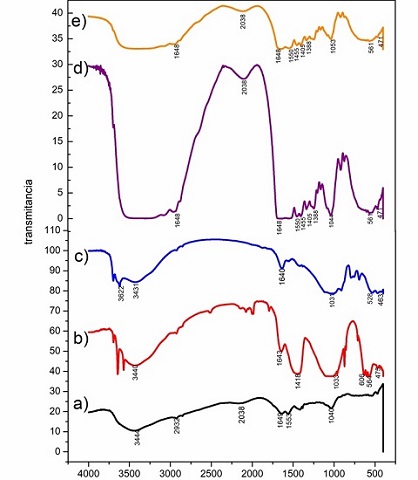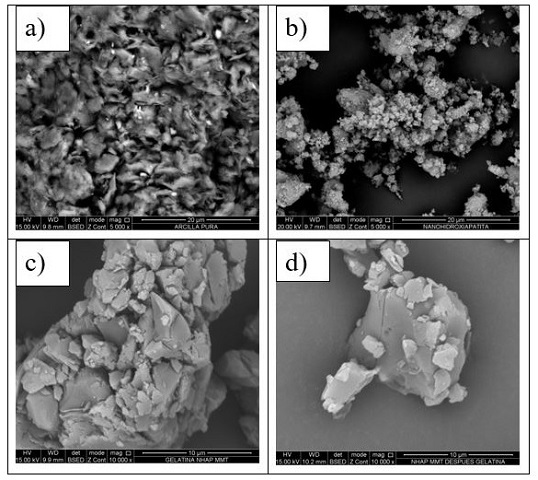Autores
Martinez, M. (UNIVERSIDAD DE CALDAS) ; Posada, M. (UNIVERSIDAD DE CALDAS) ; Rosero-moreano., M. (UNIVERSIDAD DE CALDAS) ; Jiménez, F. (UNIVERSIDAD AUTONOMA) ; Giraldo, L. (UNIVERSIDAD AUTONOMA) ; Hincapie, D. (UNIVERSIDAD AUTONOMA) ; Rodríguez, Y. (PROGEL S.A.S) ; Lellesch, L. (PROGEL S.A.S)
Resumo
New nanocomposites were prepared from non-toxic, biodegradable materials such as
montmorillonite clay (MMT), hydroxyapatite (HAP) and gelatin (Gel). First, a
MMT/HAP couple was prepared and, once purified, Gel was added to form a
(MMT/HAP)+Gel triad. Alternatively, an analog triad was prepared by simultaneous
mixing of the three precursors (MMT/HAP/Gel). The resulting materials were
characterized by FT-IR, SEM and XRD, and biocompatibility tests in human blood
plasma were carried out. Both materials proved to have good biocompatibility
attribute, and the best cellular response was obtained with the MMT/HAP/Gel
material. These preliminary results suggest that this material is promising for
potential applications in the regeneration of bone tissue.
Palavras chaves
MMT/HAP/Gel; biocompatibility; bone regeneration
Introdução
Conceptual and technological developments in the science of clays have
demonstrated their interactions with polymers, biomolecules and cells, so that
hybrid nanocomposites have potential applications in tissue regeneration (DAWSON
et al, p. 4069, 2013) (KERATIVITAYANAN et al, p. 1600, 2015) and their synthesis
is very deserving. Currently, scientists’ interest has focused on the development
of nanocomposites for applications in the field of tissue engineering. Due to
their biocompatibility and biodegradability characteristics, natural
nanocomposites have been replacing the use of synthetic materials (KATTI et al, p.
3, 2008). Montmorillonite (MMT) and other clays have great potential as
biomaterials due to their adsorption and cation exchange properties (MOUSA et al,
p. 204, 2018), while hydroxyapatite (HAP) is highly recognized for its
biocompatibility and ability to stimulate the growth of bone apatite both in vitro
and in vivo (DAWSON et al, p. 4069, 2013). The individual and collective
characteristics of MMT and HAP make very promising their application in bone
tissue regeneration, and it is expected that these qualities can be enhanced by
complementing them with a natural biopolymer such as gelatin, since its structure
might increase its biocompatibility and its hydrophilicity.
The present work deals with the synthesis of new hybrid nanocomposites prepared
from the combination of montmorillonite (MMT), hydroxyapatite (HAP) and gelatin
(Gel). The characterization of these nanocomposites involves X-ray diffraction
(XRD), scanning electron microscopy (SEM) and Fourier-transformed infrared
spectroscopy (FTIR). The biocompatibility study of the nanocomposites was carried
out using human blood plasma.
Material e métodos
Obtaining nanocomposites of MMT/HAP/Gel and (MMT/HAP)+Gel
Synthesis of the materials was inspired in a previous work reported in the
literature (OLAD et al, p. 100061, 2014) with modifications. Two mixing procedures
were applied. As a first method, MMT and HAP (2:1) were added to 50 mL of a 0.1 M
solution of acetic acid, and then gelatin (90% of the mixture) completed the triad
if components. As a second method, the same proportions of the materials were used
and mixed simultaneously. In both procedures, the solutions were mixed and stirred
during 24 h at room temperature, and the respective precipitates were washed three
times with 0.1 M aqueous NaOH. The resulting brown solid was oven-dried at 40°C
for 12 h.
Biocompatibility tests
For biocompatibility analysis, platelet adhesion protocol (RAJAN et al, p. 112342,
2022) was applied using 5 mL of blood and 200 mg of each of the samples. From the
resulting images, platelets were then counted and their average size was
determined with the aid of ImageJ® software.
Physicochemical characterization of materials
All materials (MMT/HAP)+Gel and MMT/HAP/Gel) were characterized by scanning
electron microscopy (SEM) and Fourier-transformed infrared (FTIR) spectroscopy on
KBr pellets (using a model IR Affinity-1 FTIR (Shimadzu, Kyoto, Japan). SEM
analysis was performed using a JEOL5910 LV instrument with a secondary electronic
detector. XRD characterization was performed in a Bruker D-8 Advanced-Germany
instrument, using radiation CuKα, λ=1.5406 Å generated at 35 kV and 25 mA. Data
were collected over a range 2 θ between 10° and 60°.
Resultado e discussão
As observed in Fig. 1, in addition to the expected amide absorptions which are
typical of gelatin (CHAIBI et al, p. 2741, 2015), (MMT/HAP)+Gel and MMT/HAP/Gel
materials exhibit a peak around 1386 cm-1, which is typically associated with the
vibrations of the OH groups on the surface of the MMT/HA material (WANG et al, p.
390, 2020). The peak around 2038 cm-1 is related to the formation of hydrogen
bonds of C-N groups with OH groups (CHAIBI et al, p. 2741, 2015). As expected,
FTIR spectrum shows vibrational absorptions typical of MMT, HAP and Gel as well in
the synthesized triads. HAP and MMT XRD pattern exhibits the peaks as reported in
the literature (LAABD et al, p. 116705, 2021). The diffractogram of the couple
MMT/HAP (the precursor of (MMT/HAP)+Gel) shows the characteristic peaks of the
precursor materials, which allows to conclude that the materials are conserved and
were not destroyed upon mixing together. XRD characterization of the final triads
is in due course. The SEM micrographs of all the materials are presented in Fig.
2. In comparison to the precursors, important changes in the morphology of the
triads (MMT/HAP)+Gel and MMT/HAP/Gel are observed (Fig. 2c and 2d) although the
flake morphology, characteristic of layered materials, is
preserved.Biocompatibility of the materials (MMT/HAP)+Gel and MMT/HAP/Gel was
evaluated using platelet morphology between 0 and 240 minutes. Platelets were
formed in the presence of any of the tested materials, with sizes less than 5 um,
which strongly suggests an adequate biological response for both materials. The
combined results of the experiments suggest that the synthesis protocol has an
effect on the qualities of the biomaterials. The MMT/HAP/Gel material is the one
that exhibits a better cellular response.

(a) Gelatin, (b) HAP, (c) MMT, (d) (MMT/HAP)+Gel, (e) MMT/HAP/Gel

(a) MMT, (b) HAP, (c) MMT/HAP/Gel, (d) (MMT/HAP)+Gel
Conclusões
The triads were obtained and their preliminary characterization by FTIR suggests a
similarity in their chemical composition. SEM analysis shows important differences
in the morphology of these materials, which are in accordance with the results
obtained in the biocompatibility tests. Comparative XRD analyses will be an
important key to understand physical properties of the final triads. Although both
materials gave a good platelet response, the MMT/HAP/Gel triad suggests that it is
a more promising material in our attempt to promote them as potential tissue
regenerating agents.
Agradecimentos
This research work is being financed by Universidad de Caldas (VR Investigaciones
y Posgrados) project code 0311821, and Universidad Autónoma de Manizales (VR de
Investigaciones), project code 164-117.
Referências
CHAIBI, S.; BENACHOUR, D.; MERBAH, M.; ESPERANZA CAGIAO, M.; BALTÁ CALLEJA, F. J. The role of crosslinking on the physical properties of gelatin based films. Colloid and Polymer Science, n. 293, 2741- 2752, 2015.
DAWSON, J. I.; OREFFO, R. O. C “Clay: New Opportunities for Tissue Regeneration and Biomaterial Design.” Advanced Materials, n. 25 (30), 4069–86, 2013.
KATTI, K. S.; KATTI, D. R.; DASH, R. Synthesis and characterization of a novel chitosan/montmorillonite/ hydroxyapatite nanocomposite for bone tissue engineering. Biomedical Materials, n. 3 (3), 2008.
KERATIVITAYANAN, P.; CARROW, J. K.; GAHARWAR, A. K. “Nanomaterials for Engineering Stem Cell Responses.” Advanced Healthcare Materials, n. 4 (11), 1600–1627, 2015.
LAABD, M.; BRAHMI, Y.; EL IBRAHIMI, B.; HSINI, A.; TOUFIK, E. ABDELLAOUI, Y.; ABOU OUALID, H.; EL OUARDI, M.; ALBOURINE, A. A novel mesoporous Hydroxyapatite@Montmorillonite hybrid composite for high-performance removal of emerging Ciprofloxacin antibiotic from water: Integrated experimental and Monte Carlo computational assessment. Journal of Molecular Liquids, n. 338, 116705, 2021.
MOUSA, M.; EVANS, N. D.; OREFFO, R. O.C.; DAWSON, J. I. “Clay Nanoparticles for Regenerative Medicine and Biomaterial Design: A Review of Clay Bioactivity.” Biomaterials, n. 159, 204–14, 2018.
OLAD, A.; AZHAR, F. F. The synergetic effect of bioactive ceramic and nanoclay on the properties of chitosan–gelatin/nanohydroxyapatite–montmorillonite scaffold for bone tissue engineering. Ceramics International, n. 40, 100061- 10072, 2014.
RAJAN, T.; DAS, M.; AROCKIARAJAN, A. Biocompatibility and corrosion evaluation of niobium oxide coated AZ31B alloy for biodegradable implants, Colloids and Surfaces B: Biointerfaces, n. 212, 112342, 2022.
WANG, Y.; WANG, Y.; YU, L.; WANG, R.; ZHANG, X. Highly effective microwave induced catalytic degradation of Bisphenol A in aqueous solution using double-perovskite intercalated montmorillonite nanocomposite, Chem. Eng. J, n. 390, 2020.
















